African Safaris Kenya Tanzania: Best Itineraries & Tips
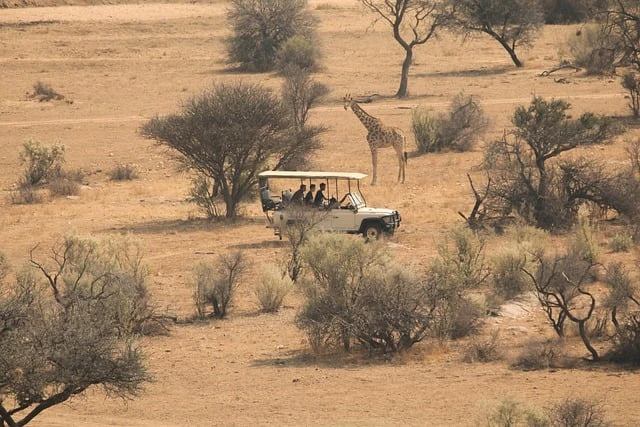
Embarking on an African safari in Kenya and Tanzania is like stepping into a living tapestry of wild beauty and timeless traditions. A world where the most breathtaking landscapes exist and where the thrill of the wild meets the richness of cultural heritage.
This article serves as your ultimate guide to navigating the wonders of these two iconic safari destinations. From meticulously crafted itineraries that span the breathtaking landscapes of Kenya and Tanzania to insider tips on the best times to witness the Great Migration and encounter the Big Five, we’ll provide you with everything you need to plan an unforgettable adventure. Dive in to discover the secrets of an African safari, where every moment is an opportunity to connect with nature’s most spectacular displays.
Introducing Kenya Luxury Safari
At Kenya Luxury Safari, we specialize in offering exceptional safari experiences across both Kenya and Tanzania. With a deep understanding of the diverse landscapes and rich cultural heritage of East Africa, we provide personalized safaris that capture the essence of this remarkable region.
What sets us apart is our dedication to crafting bespoke itineraries tailored to your unique preferences, ensuring that every detail of your journey is meticulously planned. Whether you’re seeking the thrill of a game drive in the Serengeti, the serene beauty of Ngorongoro Crater, or the cultural richness of Maasai traditions, we create experiences that go beyond the ordinary. With Kenya Luxury Safari your safari is not just a trip—it’s a personalized journey that immerses you in the heart of Africa’s most breathtaking landscapes, with the comfort and luxury that only the best can provide.
To book your Kenya-Tanzania safari, call or WhatsApp us at +25471922240 or send us an email at these email addresses;
Executive Summary
This article;
- Provides insights on the optimal times for wildlife viewing, focusing on the dry seasons and the peak of the Great Migration.
- Describes various safari options such as private safaris, group camping safaris, and luxury lodge safaris, highlighting what each offers and their costs.
- Highlights top wildlife experiences, including the Great Migration and the Big Five, and cultural encounters like Maasai village visits and local markets.
- Covers essential travel information including visa requirements, vaccinations, packing tips, and logistics for getting around Kenya and Tanzania.
- Offers detailed 7, 10, and 14-day sample itineraries for exploring Kenya and Tanzania, highlighting key parks and must-see experiences
Video Overview: African Safaris Kenya Tanzania
Why Choose a Kenya- Tanzania Safari?
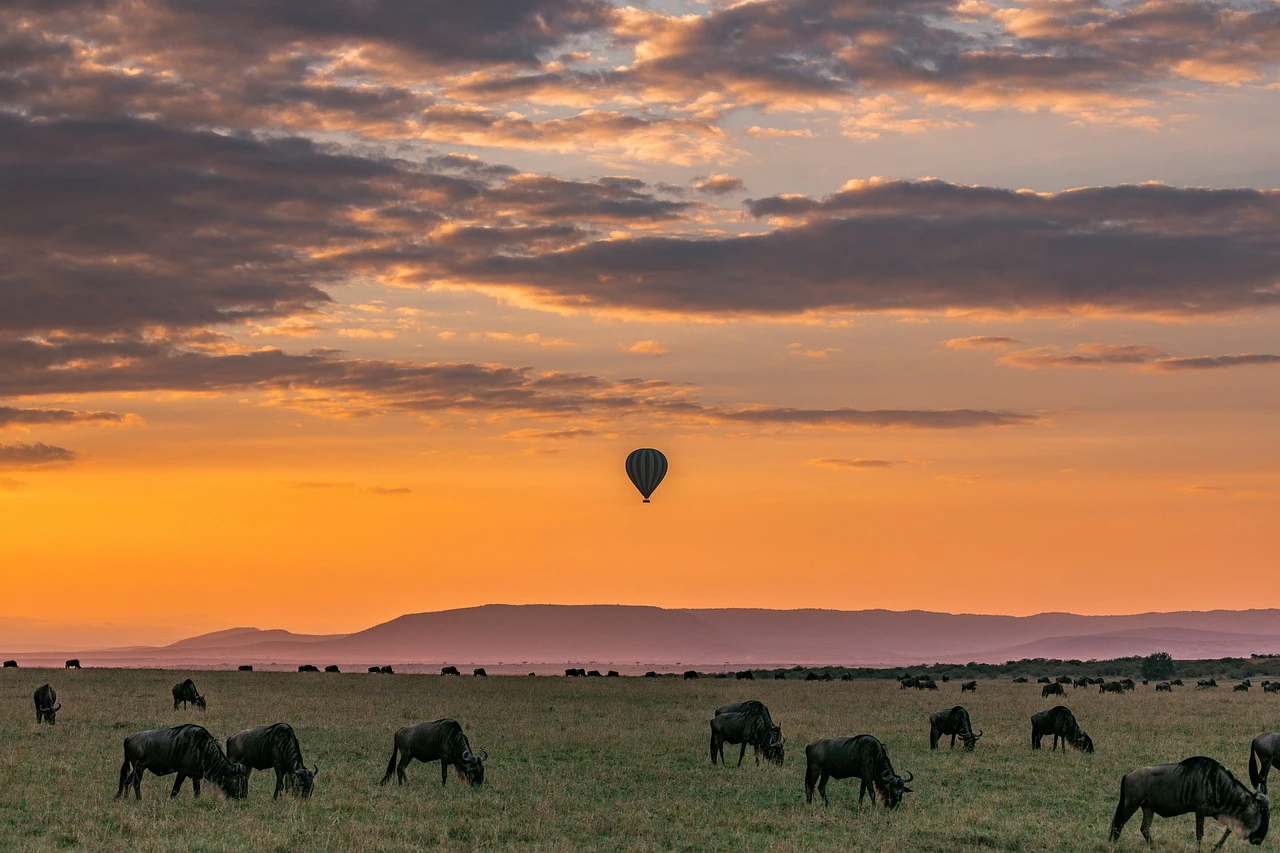
Embarking on Kenya and Tanzania safari tours invites you into a realm of adventure, where each moment resonates with wonder. These two countries in East Africa are famed for their diverse landscapes, ranging from the snow-capped peaks of Mount Kilimanjaro to the arid plains of the Serengeti and the lush greenery of Nairobi National Park. The combination of these varied terrains creates a habitat for an incredible array of wildlife, making it a paradise for nature enthusiasts and photographers alike.
Witnessing the Great Wildebeest Migration stands out as a powerful incentive for undertaking a Kenya and Tanzania safari. This spectacular event involves millions of wildebeest, zebras, and antelope traversing the plains in search of greener pastures, offering one of the most dramatic and breathtaking wildlife spectacles on earth. The Masai Mara and Serengeti National Parks are iconic locations where you can see this awe-inspiring migration up close. Moreover, these parks are home to the Big Five—lion, leopard, elephant, buffalo, and rhino—ensuring that every game drive is filled with thrilling encounters.
Beyond the wildlife, a combined Kenya and Tanzania safari offers rich cultural experiences. Visiting Maasai and other indigenous communities allows you to learn about their traditional way of life, partake in their dances, and even purchase handcrafted beadwork and jewelry. Guides, armed with experience and knowledge, guarantee a safe and enlightening safari, allowing you to fully appreciate the natural and cultural marvels of these regions. Combining these elements makes a safari tour in Kenya and Tanzania an unforgettable journey, filled with moments that will stay with you forever.
Best Time to Visit Tanzania and Kenya
The best time to visit Tanzania and Kenya is during the dry season. The dry season in Kenya runs from June to October. In Tanzania, it extends from June to November. During these months, the savannah vegetation is thinner, making it easier to spot wildlife. Water sources become scarce, drawing animals to rivers and waterholes, which enhances your chances of witnessing thrilling predator-prey interactions.
The Great Migration, one of the most sought-after wildlife events, is best viewed between July and September. During this period, the wildebeest migration moves from the Serengeti National Park in Tanzania to Kenya’s Masai Mara National Reserve. This is also the time when river crossings occur, and you can watch as thousands of animals brave the crocodile-infested waters of the Mara River.
Alternatively, if you prefer less crowded times and lower prices, consider scheduling your visit during the off-peak season, between April-May and November-December. While there might be occasional rains, the landscapes are lush, and the birdlife is particularly vibrant.
Popular National Parks to Visit in Kenya and Tanzania
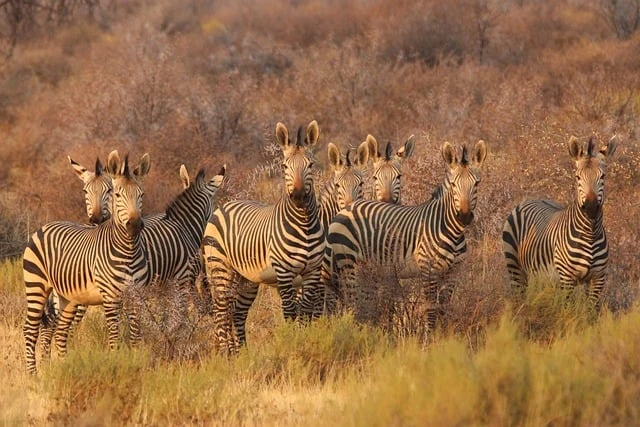
Kenya and Tanzania are home to several globally renowned national parks, each providing distinct wildlife encounters and stunning landscapes. Kenya’s Masai Mara National Reserve, is a famous wildlife reserve renowned for its vast plains and the annual Great Migration of over two million wild animals. It is a paradise for wildlife enthusiasts, hosting more than 95 mammal species, including the Big Five (lion, leopard, elephant, buffalo, and rhino).
The Serengeti National Park in Tanzania is another must-visit destination. Known for its vast open plains, the Serengeti offers:
- A high concentration of big cats, including lions, cheetahs, and leopards
- Rich birdlife, with over 500 species
- Vast, open landscapes that truly live up to its name, which means ‘Endless plains’ in the Maasai language
- Unparalleled opportunities to witness the Big Five and other wildlife in their natural habitat
The Ngorongoro Crater, part of the Ngorongoro Conservation Area, is also a worthy mention. The crater is the world’s largest inactive volcanic caldera and is home to about 25,000 animals. The crater’s unique ecosystem supports a diverse range of wildlife, including elephants, lions, and rare black rhinos. A visit to the crater rim provides breathtaking views of this natural wonder and the wildlife below.
Fourth on the list is Lake Nakuru National Park in Kenya, a Great Rift Valley lake famous for its high density of wildlife, including:
- Black and white rhinos
- Lions
- Leopards
- Buffaloes
- Rothschild giraffes
Bird enthusiasts will be thrilled by the sight of thousands of pink flamingos that create a pink shoreline around the lake. Whether you’re interested in big game or bird watching, Lake Nakuru offers a rich and diverse wildlife experience.
Planning Your Kenya and Tanzania Safari Itinerary
Crafting a Kenya and Tanzania safari itinerary is vital to guarantee a memorable and enriching experience. We’ve formulated these itineraries to allow you to explore the highlights of both countries at your own pace, ensuring you don’t miss any key attractions. Whether you prefer a short, action-packed trip or a leisurely, in-depth exploration, there are various itineraries tailored to suit your preferences and budget.
Sample 7-Day Itinerary
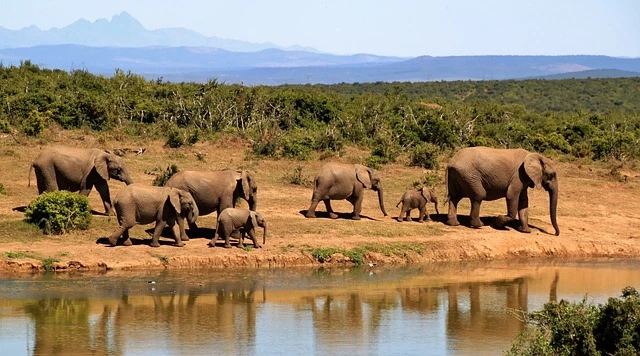
A 7-day itinerary offers a compact yet comprehensive holiday experience, covering some of the most iconic parks in Kenya and Tanzania. Start your journey in Kenya with a visit to Amboseli National Park, known for its large elephant herds and stunning views of Mount Kilimanjaro. Spend a night near the park to maximize your game viewing opportunities.
Next, head to the Masai Mara National Reserve for two days of thrilling game drives, where you can witness the Big Five and the Great Migration. Cross into Tanzania and visit Lake Manyara National Park, famous for its tree-climbing lions and diverse birdlife.
Continue to the Serengeti National Park for a day of game drives and an overnight stay in a tented camp or lodge within the park. Conclude your safari with a visit to the Ngorongoro Crater, where you can enjoy a full-day game drive and marvel at the rich wildlife within the crater.
Sample 10-Day Itinerary
For those seeking a more luxurious and extended safari, a 10-day itinerary is ideal. Here is a suggested itinerary:
- Begin your adventure in Nairobi, Kenya.
- Travel to Amboseli National Park in Southern Kenya for a day of game drives and overnight at a luxury lodge.
- Continue to Lake Nakuru National Park to see the rhinos, awesome landscapes, and over 450 bird species including flamingos and the African fish eagle.
- Head to the Masai Mara Game Reserve for three days of immersive wildlife viewing.
Cross into Tanzania and explore the following:
- Serengeti National Park, where you can witness the wildebeest migration and enjoy a picnic lunch and a hot air balloon safari
- Ngorongoro Crater
- Tarangire National Park
- Lake Manyara National Park
End your safari with a relaxing stay in Zanzibar, where you can indulge in beach activities and explore Stone Town.
Sample 14-Day Itinerary
A 14-day itinerary offers an in-depth exploration of the best parks and cultural experiences in Kenya and Tanzania. Here is a suggested itinerary:
- Start in Nairobi
- Visit Amboseli National Park
- Explore Aberdare National Park
- Discover the northern parks of Kenya, such as Samburu National Reserve, which are famous for their unique wildlife and stunning scenery
- Continue to Ol Pejeta Conservancy for a chance to see rhinos
- Head to Lake Naivasha National Park for bird watching and boat rides
- Spend three days in the Masai Mara National Reserve, witnessing the Great Migration and enjoying morning and afternoon game drives.
From day 8 onwards, explore these Tanzania’s national parks;
- Serengeti National Park
- Ngorongoro Crater
- Tarangire National Park
- Lake Manyara National Park
- End your safari with a few days in Zanzibar, where you can:
- relax on the beach
- go scuba diving
- visit historical sites like Stone Town.
Types of Safaris Available
In planning a Kenya and Tanzania safari, it’s important to select a safari type that aligns with your preferences and budget. Whether you’re looking for a private, group camping, or luxury lodge safari, each option offers unique experiences and amenities.
Below, we explore the different types of safaris available and what you can expect from each.
Private Safaris
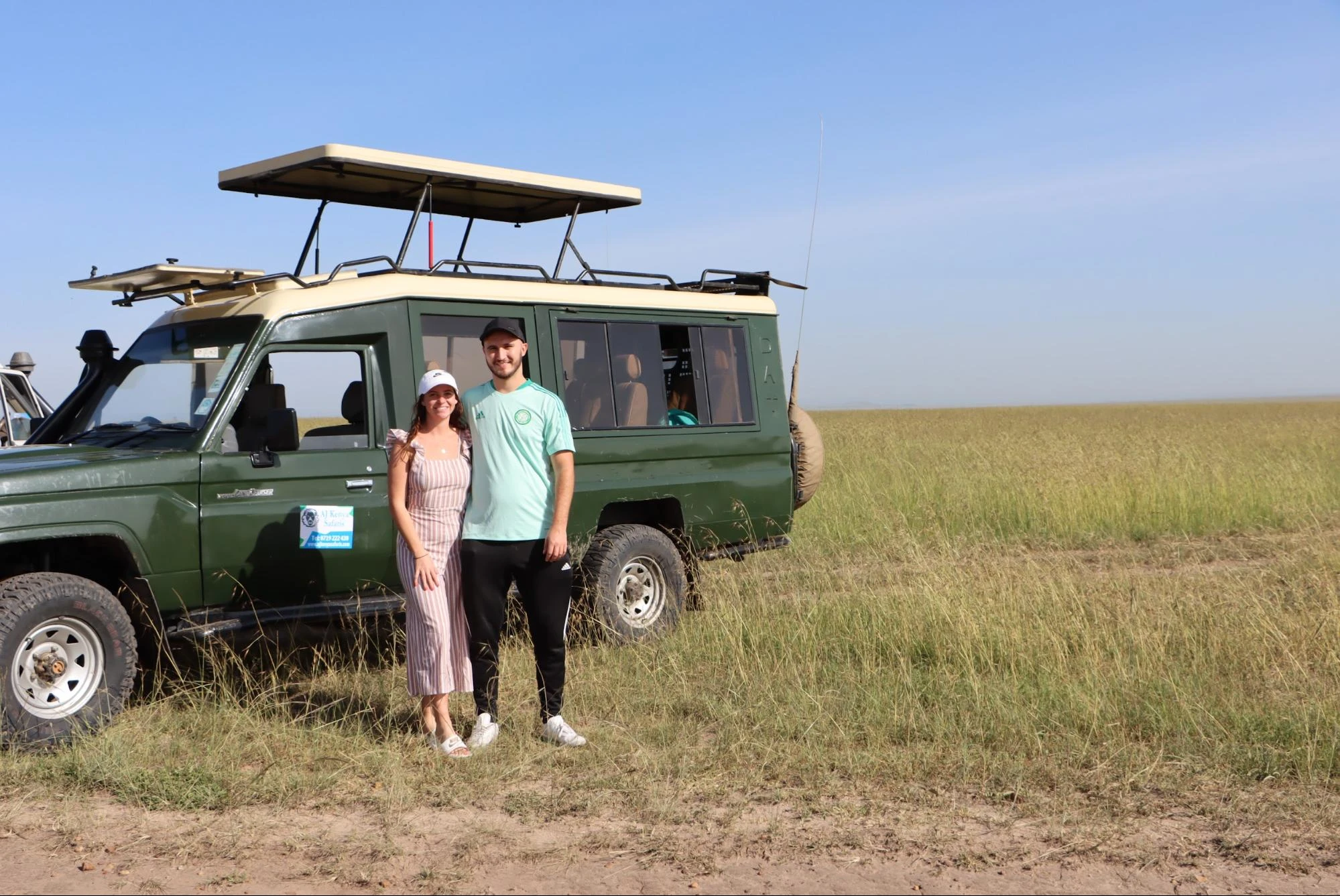
Private safaris offer a personalized and exclusive experience, allowing you to tailor your itinerary to your interests and schedule. These safaris typically include:
- 4×4 Land Cruisers equipped with pop-up roofs for excellent wildlife viewing
- Flexibility in terms of timing and activities
- Personalized service from experienced guides
- Access to remote areas for close wildlife sightings
The cost of a private safari in Kenya and Tanzania starts from around \$300 per person per day, with some local tour operators offering rates as low as \$280 per person per day.
The benefits of a private safari include flexibility, personalized service, and the ability to access remote areas for close wildlife sightings.
In addition to the enhanced safari experience, private safaris often include accommodations in luxury lodges or tented camps, providing a comfortable and intimate setting to relax after a day of adventure. Whether you’re traveling with family, friends, or as a couple, a private safari ensures that your safari is tailored to your needs and preferences.
Group Camping Safaris
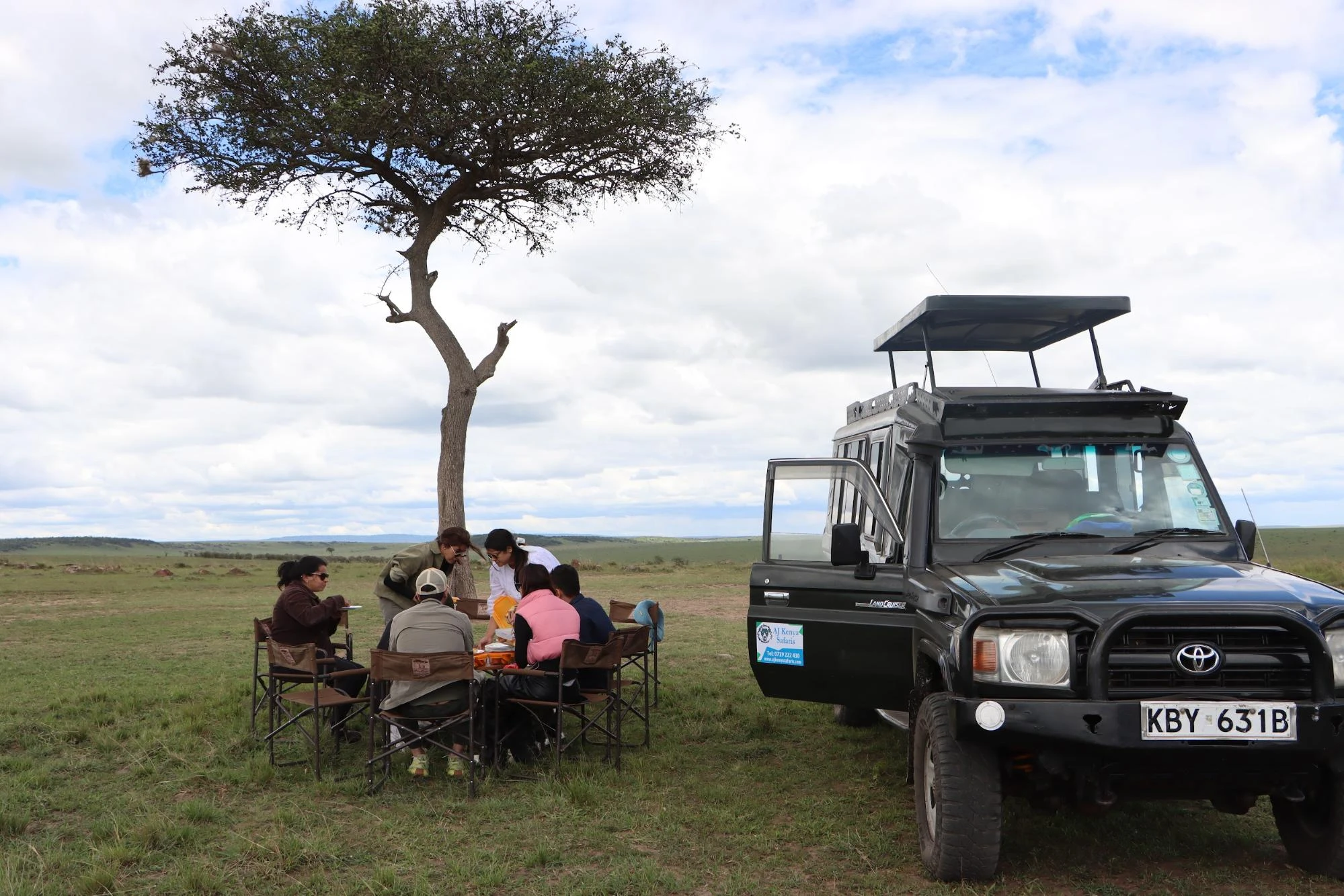
Group camping safaris are an excellent option for budget-conscious travelers and those who enjoy the camaraderie of shared adventures. These safaris typically cost around $160 to $190 per person per day, making them a more affordable alternative to private safaris. Group camping safaris use specially equipped safari trucks that provide comfort and convenience, often featuring amenities like plug sockets and fridges.
These safaris offer a unique opportunity to meet fellow travelers and share experiences around the campfire. Despite the lower cost, group camping safaris still provide fantastic wildlife viewing opportunities, with guided game drives in national parks like the Masai Mara, Serengeti, and Ngorongoro Crater. If you’re an adventurous solo traveler or simply looking to connect with like-minded individuals, a group camping safari is a perfect choice.
Luxury Lodge Safaris
For those seeking the ultimate in comfort and style, luxury lodge safaris offer an unparalleled experience. Staying in world-class lodges and tented camps, you can enjoy amenities such as fine dining, spa treatments, and private dinners under the stars. These lodges are often located in prime wildlife viewing areas, ensuring that your safari is as convenient as it is luxurious.
Unique experiences, such as having breakfast with Rothschild giraffes at Giraffe Manor or taking a hot air balloon ride over the Serengeti, add an extra layer of magic to your safari. While luxury accommodation costs more, the exceptional service and unforgettable experiences make it a worthwhile investment for a dream safari.
How to Book Your Safari
While booking your safari may seem intimidating, comprehending the various options at your disposal can streamline the process. Whether you choose to book through local tour operators, online booking platforms, or travel agents, each method has its benefits and considerations.
Below, we delve into these options to help you make an informed decision that suits your needs and preferences.
Local Tour Operators
Booking with local tour operators offers several advantages, including:
- Cost savings
- Personalized service
- Handling all logistics, from booking accommodations and arranging transportation to purchasing permits and park fees
- Enjoying a seamless safari experience that includes accommodation, meals, park fees, and an expert guide
- Customized trips tailored to your preferences and budget
- Competitive rates compared to overseas companies or travel agents
- In-depth knowledge of the region
Online Booking Platforms
Online booking platforms offer the convenience of comparing prices and reading reviews to make informed decisions. These platforms provide access to customer feedback and ratings for different safari options, allowing you to choose the best package for your needs.
By leveraging these tools, you can ensure that your safari experience meets your expectations and fits within your budget.
Travel Agents
Travel agents bring expertise and the ability to manage complex itineraries, making them an excellent choice for first-time safari-goers. They can handle all aspects of your trip, from flights and accommodations to safari tours and activities, ensuring a smooth and stress-free planning process.
Using a travel agent can save you time and provide peace of mind, especially if you’re unfamiliar with the logistics of a Kenya and Tanzania safari.
Essential Travel Information
Getting ready for your Kenya and Tanzania safari goes beyond merely reserving flights and accommodations. Essential travel information, such as visa requirements, vaccinations, and packing lists, is crucial to ensure a smooth and enjoyable trip.
Below, we provide detailed information on these key aspects to help you get ready for your safari.
Visa Requirements

Before traveling to Kenya and Tanzania, ensure you have the necessary visas and travel documents. Travelers must apply for an Electronic Travel Authorization (eTA) before visiting Kenya, with a single-entry visa costing approximately $51 USD. For Tanzania, visa applications can be completed online through the official portal.
Remember to have at least two blank passport pages for each country visited to avoid any issues at border crossings.
Vaccinations and Health Precautions
Staying healthy during your safari is paramount, and vaccinations play a crucial role. Here are some recommended vaccinations for travelers:
- Yellow Fever: Proof of Yellow Fever Vaccination is mandatory for travelers arriving in Kenya and Tanzania from countries with a Yellow Fever risk.
- Hepatitis A: Recommended for all travelers.
- Hepatitis B: Recommended for all travelers.
- Typhoid: Recommended for all travelers.
- Rabies: Consider getting a Rabies vaccination if you plan to spend significant time outdoors or in remote areas.
Malaria is a significant concern in both Kenya and Tanzania, so taking the following health precautions is essential:
- Take anti-malarial medication
- Bring a good quality insect repellent containing DEET
- Carry a standby emergency treatment for malaria if traveling to remote areas
By taking these health precautions, you can enjoy your safari experience without worrying about your well-being.
Packing List
Packing appropriately for your safari ensures you’re prepared for the various conditions you’ll encounter. Here are some tips:
- Include lightweight, long-sleeved clothing to protect against mosquito bites
- Avoid navy blue and black, as these colors attract tsetse flies
- Consider choosing light neutral colors such as beige, light brown, grey, or cream. They can create a calming and versatile atmosphere in your space.
A wide-brimmed hat and high-factor sunscreen are essential for sun protection, while a good quality insect repellent will help keep bugs at bay. Don’t forget to bring high-factor sunscreen and insect repellent, with tubes for reapplying.
Top Wildlife Experiences
Kenya and Tanzania safaris provide some of the world’s most exceptional wildlife experiences. From witnessing the Great Migration to spotting the Big Five, these encounters will leave you in awe of nature’s wonders.
Below, we highlight some of the top wildlife experiences you can expect during your safari.
The Big Five

The Big Five—lion, leopard, elephant, buffalo, and rhino—are some of the most sought-after animals on any safari. These magnificent creatures can be found in several parks, including Kenya’s Maasai Mara and Tanzania’s Serengeti National Park. Lake Nakuru and Ol Pejeta Conservancy in Kenya are particularly notable for their strong rhino populations, offering better chances to see all of the Big Five.
Leopards are often elusive, requiring an element of luck to spot them on safaris in Kenya and Tanzania. However, with the guidance of experienced safari guides, you increase your chances of encountering these majestic animals. Seeing the Big Five in their natural habitat is a thrilling and unforgettable experience that epitomizes the essence of an African safari.
The Great Migration
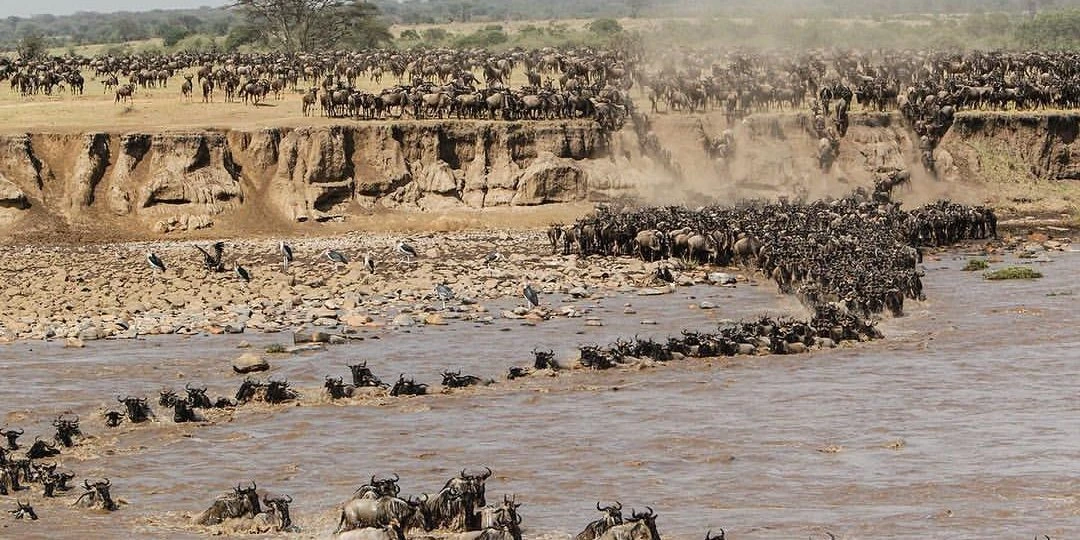
The Great Migration is one of the most spectacular wildlife events on the planet, involving over a million wildebeest, 200,000 zebras, and countless other animals moving through Kenya and Tanzania. This annual event sees these animals travel from the southern Serengeti plains in Tanzania to the Masai Mara in Kenya in search of better grazing fields. The prime time to witness the Great Migration is between mid-July and mid-September, when the wildebeest cross the Mara River.
Early June is a prime time to witness the migration in the western Serengeti, while in late July and early August, the wildebeest cross the Mara River to reach the Masai Mara. By early October, the wildebeest begin their southward journey back to the Serengeti. Viewing spots like the Elewana Serengeti Migration Camp offer excellent vantage points to witness this incredible journey and the dramatic river crossings.
Unique Species
In addition to the Big Five and the Great Migration, Kenya and Tanzania are home to unique species that add to the richness of your safari experience. One such highlight is the tree-climbing lions in Lake Manyara National Park, often found resting in acacia trees.
Lake Nakuru is renowned for its large flocks of flamingos, creating a vibrant pink shoreline that is a sight to behold. These unique species and their habitats offer diverse wildlife encounters that make your safari adventure truly special.
Cultural Highlights
In addition to spectacular wildlife, a Kenya and Tanzania safari provides enriching cultural experiences that give profound insights into local lifestyles. From visiting Maasai villages to exploring local markets and historical sites, these cultural highlights add a new dimension to your Kenya-Tanzania safari holidays adventure.
Below, we explore some of the top cultural experiences you can enjoy during your safari.
Maasai Village Visits

A visit to a Maasai village is a must for anyone interested in learning about the traditional way of life of local communities in East Africa. The Maasai people, known for their colorful shukas and intricate beadwork, live in traditional villages surrounding the Masai Mara and Serengeti. During your visit, you can witness traditional Maasai dances and rituals, which are a significant part of their cultural heritage.
Visitors often have the opportunity to purchase handcrafted beadwork and jewelry made by Maasai women, supporting the local community while taking home a unique souvenir. Sustainable tourism practices, such as those at Entamanu Ngorongoro, ensure that your visit benefits the Maasai people and fosters a positive cultural exchange.
Local Markets and Crafts
Exploring local markets and crafts provides a window into the daily life and creativity of East African communities. In Mto wa Mbu, near Lake Manyara, tourists can enjoy a village walk that includes visits to local markets and interactions with artisans. The market offers a variety of fruits, vegetables, and spices, giving you a taste of local cuisine, while artisans create beautiful wood carvings and sculptures, perfect for souvenirs.
Historical Sites
Kenya and Tanzania are rich in historical sites that reflect the diverse cultures and histories of the region. Olduvai Gorge, one of the most important paleoanthropological sites in the world, offers insights into early human evolution. The nearby museum and visitor’s center provide fascinating exhibits about the discoveries made by Louis and Mary Leakey.
Stone Town in Zanzibar, with its blend of Swahili, Arab, Persian, and European architecture, and the ruins of Kilwa Kisiwani, a UNESCO World Heritage site, are also must-visit historical landmarks.
Logistics and Transportation
Coordinating the logistics of commuting between national parks in Kenya and Tanzania is a key aspect of your safari planning. Whether you choose to fly, drive, or take a bus, understanding the best transportation options can enhance your travel experience and ensure you make the most of your time on safari.
Below, we outline the key logistics and transportation considerations for your safari adventure.
Getting Around
Flying is the fastest and most convenient way to travel between parks in Kenya and Tanzania. With three international airports and numerous domestic airlines, you can easily connect to various safari destinations. Chartered planes are popular for traveling between parks, with airstrips often located adjacent to the parks for easy access. Flights from Arusha to Zanzibar, for example, are available throughout the day, lasting around 1.5 hours and costing between $100 and $200 per person.
For those who prefer a more adventurous approach, self-drive safaris are an option. Renting a 4WD vehicle allows you to explore the parks independently and at your own pace. However, keep in mind that park entry is generally restricted to specialized safari trucks, requiring additional arrangements.
Buses also provide an affordable means of travel, with an expansive network covering major cities and even reaching neighboring countries.
Border Crossings
Crossing the border between Kenya and Tanzania is a common part of many safari itineraries. The main border crossing is the Namanga border post, which is widely used for overland travel between the two countries. Ensure you have the necessary visas and travel documents to facilitate a smooth transition.
Safari tours often handle border crossing logistics, making it easier for tourists to move seamlessly between Kenya and Tanzania.
Summary
A Kenya and Tanzania safari offers an unparalleled adventure filled with breathtaking wildlife encounters, rich cultural experiences, and stunning landscapes. By planning your itinerary carefully, choosing the right type of safari, and ensuring you have all the essential travel information, you can make the most of your dream safari. From witnessing the Great Migration to exploring Maasai villages, every moment of your safari will be filled with wonder and excitement.
As you embark on your safari adventure, remember that the real magic lies in the unexpected moments and the connections you make with the land, its people, and its wildlife. Whether you’re a seasoned traveler or a first-time safari-goer, Kenya and Tanzania will leave an indelible mark on your heart. Start planning your safari today and prepare to be amazed by the beauty and diversity of East Africa.
Frequently Asked Questions
In this section, we answer some of your most frequently asked questions about safaris in Kenya and Tanzania.
What is the best time to visit Tanzania and Kenya for a safari?
The best time to visit Kenya and Tanzania for a safari is during the dry seasons, which are from June to October in Kenya and June to November in Tanzania. This period offers optimal wildlife viewing and the chance to witness the Great Migration.
How long should my Kenya and Tanzania safari be?
The length of your Kenya and Tanzania safari depends on your preferences and available time. A 7-day itinerary covers key highlights, while a 10-day or 14-day itinerary offers a more comprehensive experience.
What vaccinations do I need for a safari in Kenya and Tanzania?
For a safari in Kenya and Tanzania, it’s important to get the Yellow Fever vaccination, especially if you’re coming from a country with a Yellow Fever risk, along with Hepatitis A, Hepatitis B, Typhoid, and Rabies vaccinations. Stay safe and enjoy your safari adventure!
Can I book a safari directly with local tour operators?
Absolutely, booking a safari directly with local tour operators can offer cost savings and personalized service, as they handle all logistics, including accommodation, park fees, and transportation. Enjoy your trip!
What should I pack for my safari?
Pack lightweight, long-sleeved clothing in neutral colors, a wide-brimmed hat, high-factor sunscreen, and insect repellent to ensure a comfortable and safe safari experience. Avoid navy blue and black to prevent attracting tsetse flies.
Which are the Best Parks to visit in Kenya and Tanzania?
The best parks to visit in Kenya are;
- the Masai Mara Game Reserve
- Samburu Game Reserve
- Amboseli National Park
- Ol Pejeta
- Lake Nakuru National Park
The best parks for Tanzania safaris are;
- Ngorongoro Crater
- Lake Manyara National Park
- Ndere Island National Park in Lake Victoria
- Mikumi National Park in Dar es Salaam
What can I expect from afternoon safaris on a Kenya safari trip?
An afternoon game drive in Kenya offer cooler temperatures and enhanced wildlife activity, providing excellent opportunities for spotting animals and capturing stunning sunset views. Guides help track and interpret animal behavior, making for a rewarding and picturesque adventure.
What are some of the Advantages of a Self Drive Safari?
Some of the advantages of a self-drive safari include flexibility, independence, and personalized itinerary control.
